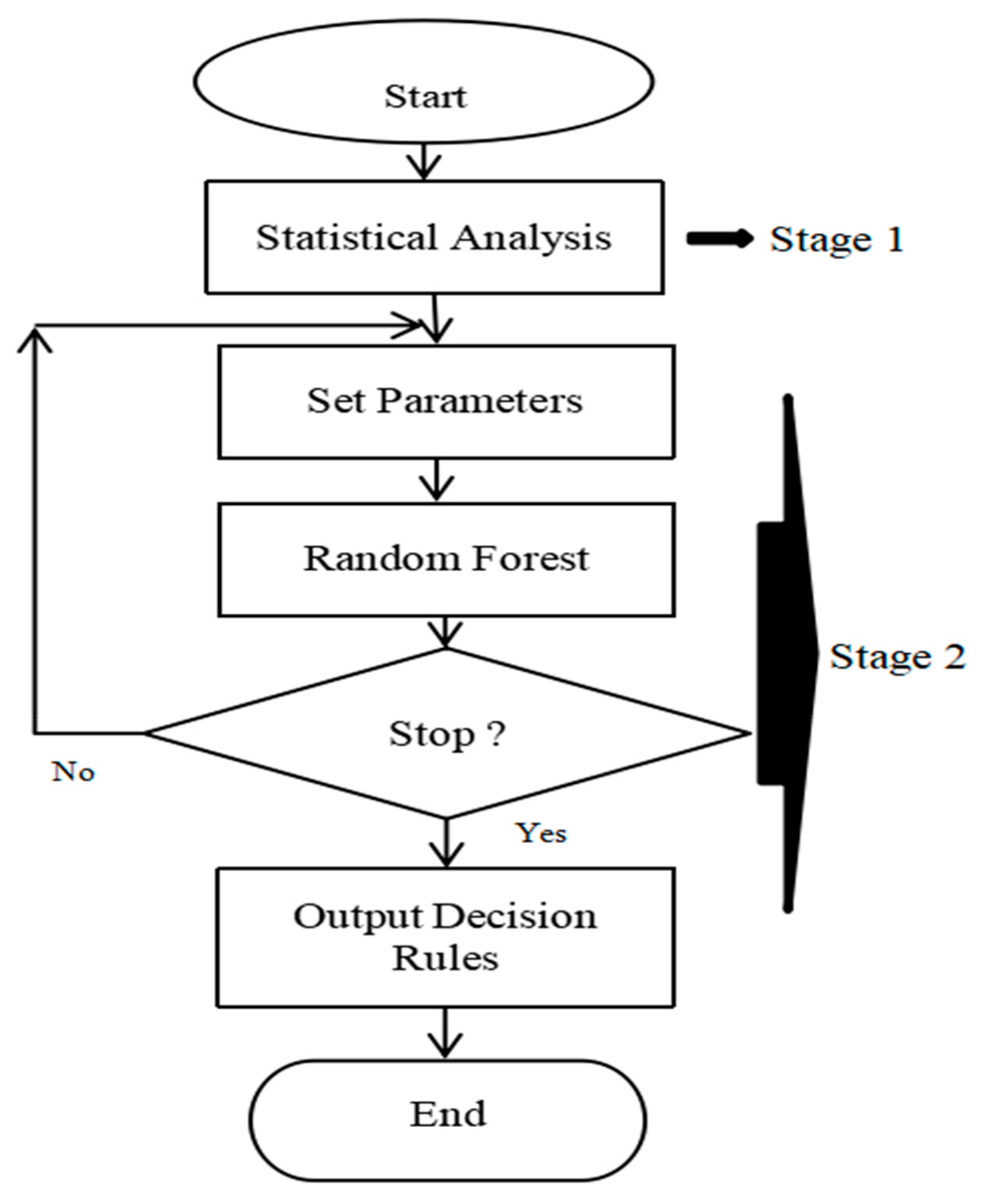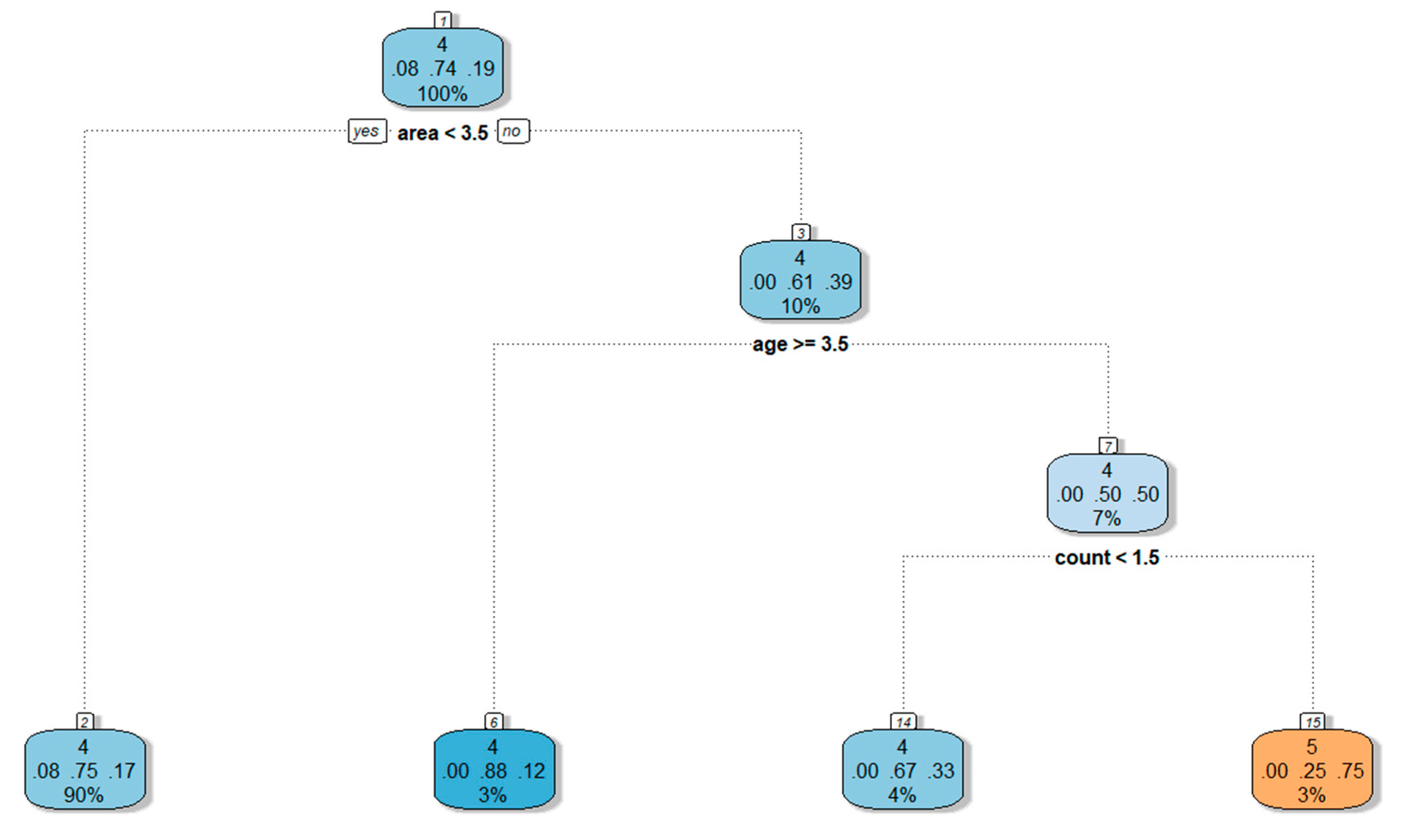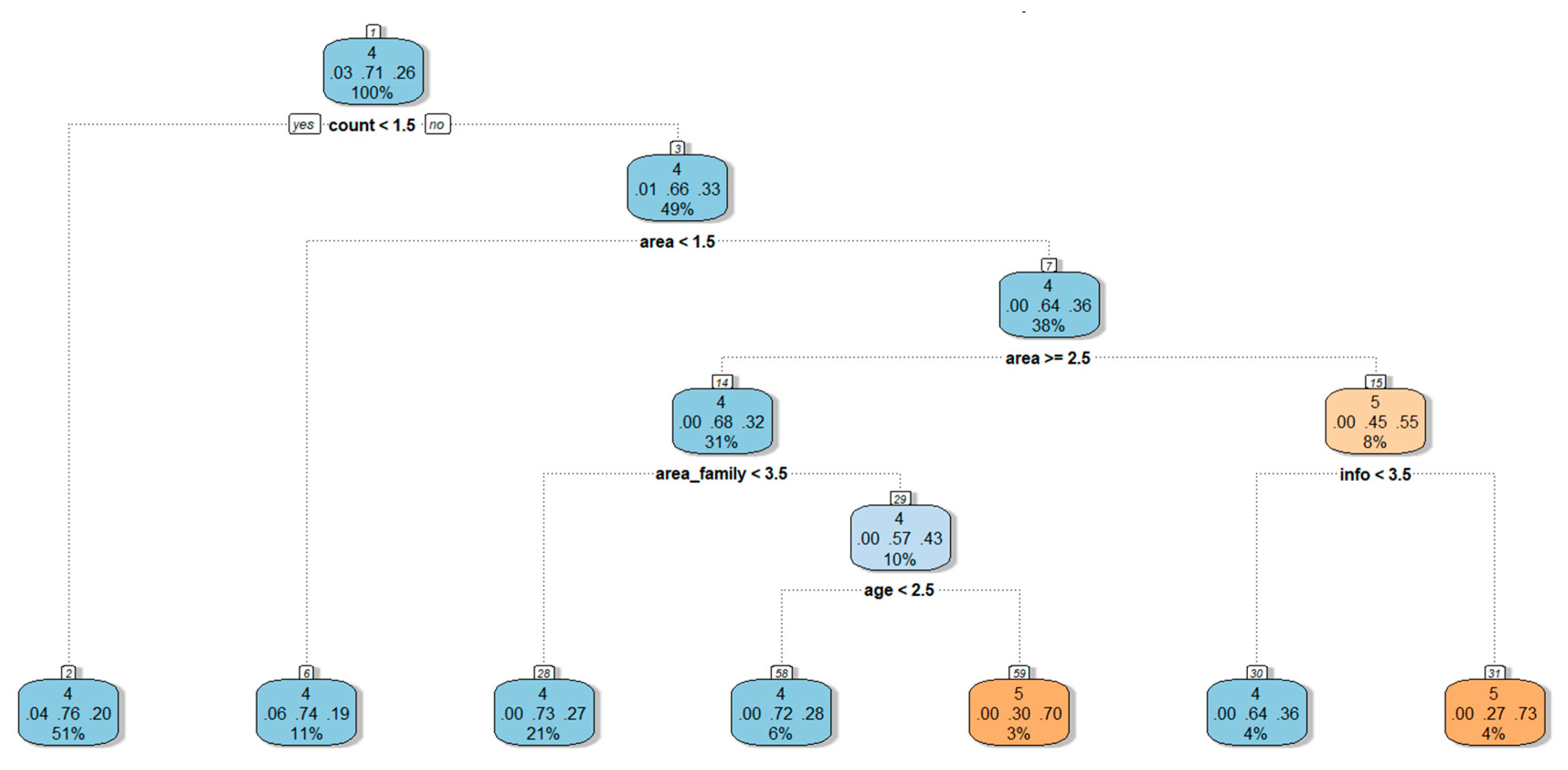A Study on the Sustainable Development for Senior Learners
Abstract
:1. Introduction
2. Methodology
2.1. Method of Decision Tree Classifier
2.2. Sample, Demographics, and the Proposed Algorithm
- Step 1.
- Select samples from the dataset.
- Step 2.
- Create an unpruned decision tree classifier for each sample. At each node, the predicted variables are randomly sampled and the best split is selected from these variables.
- Step 3.
- Decide on the new dataset by the majority votes for decision tree classifiers of the trees.
- Step 4.
- Repeat the process of Step 2 until the stop criterion is met.
- Step 5.
- Finally, output the decision rules for the decision maker.
3. Finding
3.1. Social Assistance Analysis
3.2. Inspiration Analysis
3.3. Learning Fulfillment Analysis
3.4. Random Forest Analysis
- When the senior learners inhabit the “Northern region”, “Central region”, or “Southern region”, the overall satisfaction with the fulfillment is 4 points, and the status is “satisfactory”.
- When the ages of senior learners are over 70 years and they live in the “Eastern region”, the overall satisfaction with social assistance is 4 points, and the status is “satisfactory”.
- When senior learners are involved in their “first participation” at the university, 55–69 years old, and live in the “Eastern region”, their overall social assistance satisfaction is 4 points, and the status is “satisfactory”.
- When senior learners have participated in the senior university more than twice, 55–69 years old, and live in the “Eastern region”, they are “very satisfied” overall with their social assistance (a score of 5 points).
- When the senior learners “participate for the first time”, the overall satisfaction with their inspiration is 4 points, and the status is “satisfactory”.
- When the senior learners live in the “Northern region” and have participated in the university more than two times, the overall satisfaction with their inspiration is 4 points, and the status is “satisfactory”.
- When senior learners are “living alone”, “cohabiting with a spouse”, or “cohabiting with a child”, reside in the “southern region” or “eastern region”, and have participated more than twice, the overall satisfaction of their inspiration for participation is 4 points, and the status is “satisfactory”.
- When the senior learners are aged between 55 and 64, “cohabitate with their spouses and children”, live in the “Southern region” or “East region”, and have participated more than twice, the overall satisfaction with their inspiration is 4 points, and the status is “satisfactory”.
- When the senior learners are over 65 years of age, “cohabitate with their spouses and children”, live in the “Southern region” or “East region”, and have participated more than twice, they are “very satisfied” with their inspiration (a score of 5 points).
- When senior learners’ information source for the senior university is “network information”, “friend recommendation”, or “family recommendation”, and senior learners live in the central region and have participated more than two times, the overall satisfaction with their inspiration is 4 points, and the status is “satisfactory”.
- When the senior learners’ information source is “poster, flyer” or “other”, and they live in the “central region” and have participated more than twice, they are “very satisfied” overall with their inspiration (a score of 5 points).
- When the senior learners live in the “Southern region”, their overall satisfaction with learning fulfillment is 4 points, and the status is “satisfactory”.
- When the senior learners’ information source is “family recommendation” and they live in the “Northern region” or “Central region”, their overall satisfaction with learning fulfillment is 4 points, and the status is “satisfactory”.
- When the senior learners’ education level is less than junior high, their information source is “Network information” or “friend recommendation”, and they live in the “Northern region” or “Central region”, their overall satisfaction with learning fulfillment is 4 points, and the status is “satisfactory”.
- When the senior learners are “male”, have an education level above high school, reside in the “Northern region” or “Central region”, and their information source is “Network information” or “friend recommendation”, their overall satisfaction with learning fulfillment is 4 points, and the status is “satisfactory”.
- When the senior learners live in the “Central region”, are “female”, have an education level above high school, and the information source is “Network information” or “friend recommendation”, their overall satisfaction with learning fulfillment is 4 points, and the status is “satisfactory”.
- When the senior learners live in the “Northern region”, are “female”, have an education level above the high school level, and the information source is “Network information” or “friend recommendation”, they are “very satisfied” overall with learning fulfillment (a score of 5 points).
- When the senior learners live in the “Northern region”, and the source of information is “posters, leaflets” or “other”, the overall satisfaction with their learning fulfillment is 4 points, and the status is “satisfactory”.
- When the senior learners live in the “Central region”, and the information source is “posters, leaflets” or “other”, the overall satisfaction with their learning fulfillment is 5 points, and the status is for “very satisfied”.
- When the senior learners are aged 55–64 years old, are “female”, and live in the “Eastern region”, their overall satisfaction with learning fulfillment is 4 points, and the status is “satisfactory”.
- When the senior learners are over 65 years old, are “female”, and live in the “Eastern region”, their overall satisfaction with learning fulfillment is 5 points, and the status is “very satisfied”.
- When the senior learners are “male” and live in the “Eastern region”, their overall satisfaction with learning fulfillment is 5 points, and the status is “very satisfied”.
4. Discussions of the Results
5. Limitations of Present Study and Suggestions for Future Research
6. Conclusions
Author Contributions
Funding
Acknowledgments
Conflicts of Interest
References
- Kanchana, B.; Punnarumol, T. Learner Classification Method for Senior Learning with Decision Tree: A Case Study of Thai Senior. In Proceedings of the IEEE 2018 Global Wireless Summit (GWS), Chiang Rai, Thailand, 25–28 November 2018. [Google Scholar] [CrossRef]
- Francisco, Z.-P.; Jesús, S.-M. Teaching for a Better World. Sustainability and sustainable Development Goals in the Construction of a Change-Maker University. Sustainability 2019, 11, 4224. [Google Scholar] [CrossRef]
- Rogers, K.S. Retaining adult learners: What academic leaders and faculty need to know. Recruit. Retaining Adult Learn. 2018, 20, 6–7. [Google Scholar] [CrossRef]
- Iloh, C. Not non-traditional, the new normal: Adult learners and the role of student affairs in supporting older college students. J. Stud. Aff. 2018, 27, 25–30. [Google Scholar]
- Huang, H.; Lee, Z.J.; Su, W.S. A Study on Social Support, Participation Motivation and Learning Satisfaction of Senior Learners. In International Conference on Frontier Computing; Springer: Singapore, 2018; pp. 1979–1984. [Google Scholar]
- Perna, J. Learning Styles and Their Effect on Student Learning. Senior Honors Theses, Eastern Michigan University. 2011. Available online: http://commons.emich.edu/honors/270 (accessed on 7 November 2019).
- Petter, C.; Helling, K. Designing ICT-Based learning scenarios for special target groups. Meeting senior learners needs. In Proceedings of the Workshop on Inclusive E-Learning: Special Needs and Special Solutions (IEL-2008), Maastricht, The Netherlands, June 2009. Retrieved. [Google Scholar]
- Ehiane, O.S. Discipline and academic performance (A study of selected secondary schools in Lagos, Nigeria). Int. J. Acad. Res. Progress. Educ. Dev. 2014, 3, 181–194. [Google Scholar]
- Dickhaus, T. Statistical Approaches for Epigenetic Data Analysis. In Computational Epigenetics and Diseases; Academic Press: Cambridge, MA, USA, 2019; pp. 23–32. [Google Scholar]
- Liaw, A.; Wiener, M. Classification and regression by random forest. R News 2002, 2, 18–22. [Google Scholar]
- Safavian, S.R.; Landgrebe, D. A survey of decision tree classifier methodology. IEEE Trans. Syst. Man Cybern. 1991, 21, 660–674. [Google Scholar] [CrossRef]
- Muhammed, H.H.; Ammenberg, P.; Bengtsson, E. Using feature-vector based analysis, based on principal component analysis and independent component analysis, for analysing hyperspectral images. In Proceedings of the IEEE 11th International Conference on Image Analysis and Processing, Bydgoszcz, Poland, 11–13 September 2001; pp. 309–315. [Google Scholar]
- Lee, Z.J.; Chang, L.Y. Apply Fuzzy Decision Tree to Information Security Risk Assessment. Int. J. Fuzzy Syst. 2014, 16, 265–269. [Google Scholar]
- Pourghasemi, H.R.; Saravi, M.M. Land-Subsidence Spatial Modeling Using the Random Forest Data-Mining Technique. In Spatial Modeling in GIS and R for Earth and Environmental Sciences; Elsevier: Amsterdam, The Netherlands, 2019; pp. 147–159. [Google Scholar]




| Aspects | KMO | Bartlett’s Test χ2 | Item | The Top 3 Highest Average Score |
|---|---|---|---|---|
| Social assistance | 0.86 | 1103.11 | Tool assistance | 4.18 |
| Emotional assistance | 4.17 | |||
| University support | 4.14 | |||
| Inspiration | 0.86 | 873.18 | Psychological inspiration | 4.28 |
| Physiological inspiration | 4.22 | |||
| Social inspiration | 4.10 | |||
| The learning fulfillment | 0.85 | 1220.55 | Interpersonal interaction | 4.28 |
| Growth after attending the course | 4.22 | |||
| Environmental fulfillment | 4.10 |
© 2019 by the authors. Licensee MDPI, Basel, Switzerland. This article is an open access article distributed under the terms and conditions of the Creative Commons Attribution (CC BY) license (http://creativecommons.org/licenses/by/4.0/).
Share and Cite
Lee, Z.-J.; Huang, H.; Lee, C.-Y.; Jiang, Y.-H.; Chang, C.-Y. A Study on the Sustainable Development for Senior Learners. Sustainability 2019, 11, 6338. https://doi.org/10.3390/su11226338
Lee Z-J, Huang H, Lee C-Y, Jiang Y-H, Chang C-Y. A Study on the Sustainable Development for Senior Learners. Sustainability. 2019; 11(22):6338. https://doi.org/10.3390/su11226338
Chicago/Turabian StyleLee, Zne-Jung, Hsiang Huang, Chou-Yuan Lee, Yi-Huo Jiang, and Chun-Yen Chang. 2019. "A Study on the Sustainable Development for Senior Learners" Sustainability 11, no. 22: 6338. https://doi.org/10.3390/su11226338
APA StyleLee, Z.-J., Huang, H., Lee, C.-Y., Jiang, Y.-H., & Chang, C.-Y. (2019). A Study on the Sustainable Development for Senior Learners. Sustainability, 11(22), 6338. https://doi.org/10.3390/su11226338






